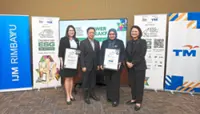Children live among piles of trash with their families here.
Compared to 25 years ago, awareness of environmental issues among the public and businesses in Malaysia has increased significantly, with more environment-related terminologies and concepts being introduced, from “reduce, reuse, recycle (3R)” to “sustainable development”, and now “ESG” and “circular economy”.
The mainstreaming of these concepts across all businesses is particularly important to ensure that business entities play their part in caring for the environment while generating profits or wealth from their operations.





